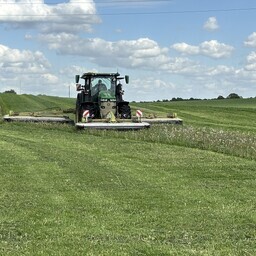Heina valmistamine sõltub ilmast
.
Hein peab täielikult kuivama
, et ta ei läheks hallitama. Silo pannakse aga kohe rulli või kilesse, kus see fermenteerub. See on nagu hapukapsa tegemine.
Heina valmistamine sõltub ilmast
Tõlge fraasile: Heina valmistamine sõltub ilmast
EN
Hay production depends on the weather
Hein peab täielikult kuivama
Tõlge fraasile: Hein peab täielikult kuivama
EN
The hay must dry completely
Läänemaa Taluliidu juhatuse esinaine Tiiu Hellerma ütleb, et Läänemaa olukord on teiste maakondadega võrreldes parem. Siin on tulnud parasjagu vihma. Ilma on heina tegemiseks vähe, aga heina mass on hea.
Saaremaal on heina- ja silosaaki mõjutanud vihmaperioodile eelnenud kuiv aeg. Saaremaa Talupidajate Liidu juhatuse esimees Jaan Kiider ütleb, et võrreldes Kagu-Eestiga elavad nad teisel mandril. Halvema ilma tõttu on saak eelmise aastaga võrreldes kehvem. Põllumees sõltub ilmast palju.
Silo on muutunud heinaga võrreldes populaarsemaks, sest selle tegemiseks kulub vähem aega. Siloga saab kiiremini, kahe päevaga ühele poole.
Heinaga peaks olema vähemalt viis päeva kuiva ilma
. Siloga on vähem riske.
Heinaga peaks olema vähemalt viis päeva kuiva ilma
Tõlge fraasile: Heinaga peaks olema vähemalt viis päeva kuiva ilma
EN
Hay requires at least five days of dry weather
Valgamaa Põllumeeste Liidu tegevjuht Kaupo Kutsar ütleb, et heinasaagi üle kurta ei saa. Silosaagi aastamahust on täitunud pool.
Probleemid tekivad saagi kättesaamisel
.
Mõndadele põldudele ei saa vihmaga peale
ning tekivad rööpad. Kui põldudel on vesi peal, ei niidetagi.
Vihmase ilma puhul võib kogu heinasaak minna raisku
.
Probleemid tekivad saagi kättesaamisel
Tõlge fraasile: Probleemid tekivad saagi kättesaamisel
EN
Problems arise during the harvest
Mõndadele põldudele ei saa vihmaga peale
Tõlge fraasile: Mõndadele põldudele ei saa vihmaga peale
EN
Some fields cannot be accessed in the rain
Vihmase ilma puhul võib kogu heinasaak minna raisku
Tõlge fraasile: Vihmase ilma puhul võib kogu heinasaak minna raisku
EN
In rainy weather, the entire hay harvest may be wasted
Sünoptikute hinnangul ei tule lähemal ajal pikemat soojaperioodi
. Üksikud soojemad päevad on aga tulekul.
Sünoptikute hinnangul ei tule lähemal ajal pikemat soojaperioodi
Tõlge fraasile: Sünoptikute hinnangul ei tule lähemal ajal pikemat soojaperioodi
EN
According to meteorologists, a longer warm period is not expected soon
Hay production depends on the weather. The hay must dry completely to avoid molding. Silage, however, is immediately rolled or packed where it ferments. It's like making sauerkraut.
Tiiu Hellerma, chairwoman of the Läänemaa Farmers' Union board, says the situation in Läänemaa is better compared to other counties. There has been just enough rain here. There hasn't been much weather for haymaking, but the hay mass is good.
In Saaremaa, the dry period before the rainy season has affected both hay and silage harvesting. Jaan Kiider, chairman of the Saaremaa Farmers' Union board, says that compared to Southeast Estonia, they live on another continent. Due to worse weather, the yield is poorer compared to last year. A farmer depends greatly on the weather.
Silage has become more popular than hay because it takes less time to make. With silage, you can work faster, covering one side in two days. With hay, you need at least five days of dry weather. Silage involves fewer risks.
Kaupo Kutsar, executive director of the Valgamaa Farmers' Union, says there's no reason to complain about the hay yield. Half of the annual silage target has been met. Problems arise when trying to collect the harvest. Some fields can't be accessed due to rain, creating ruts. If fields have standing water, they can't even be mowed. In rainy weather, the entire hay harvest can go to waste.
According to meteorologists, no prolonged warm period is expected in the near future. However, some warmer days are coming.

